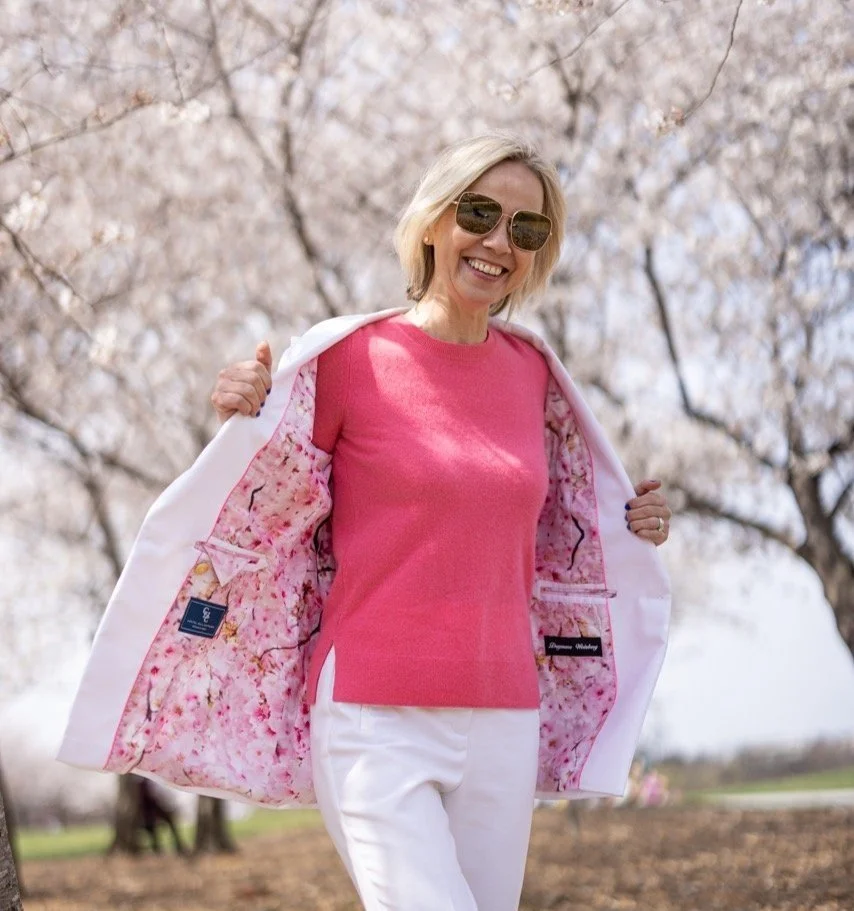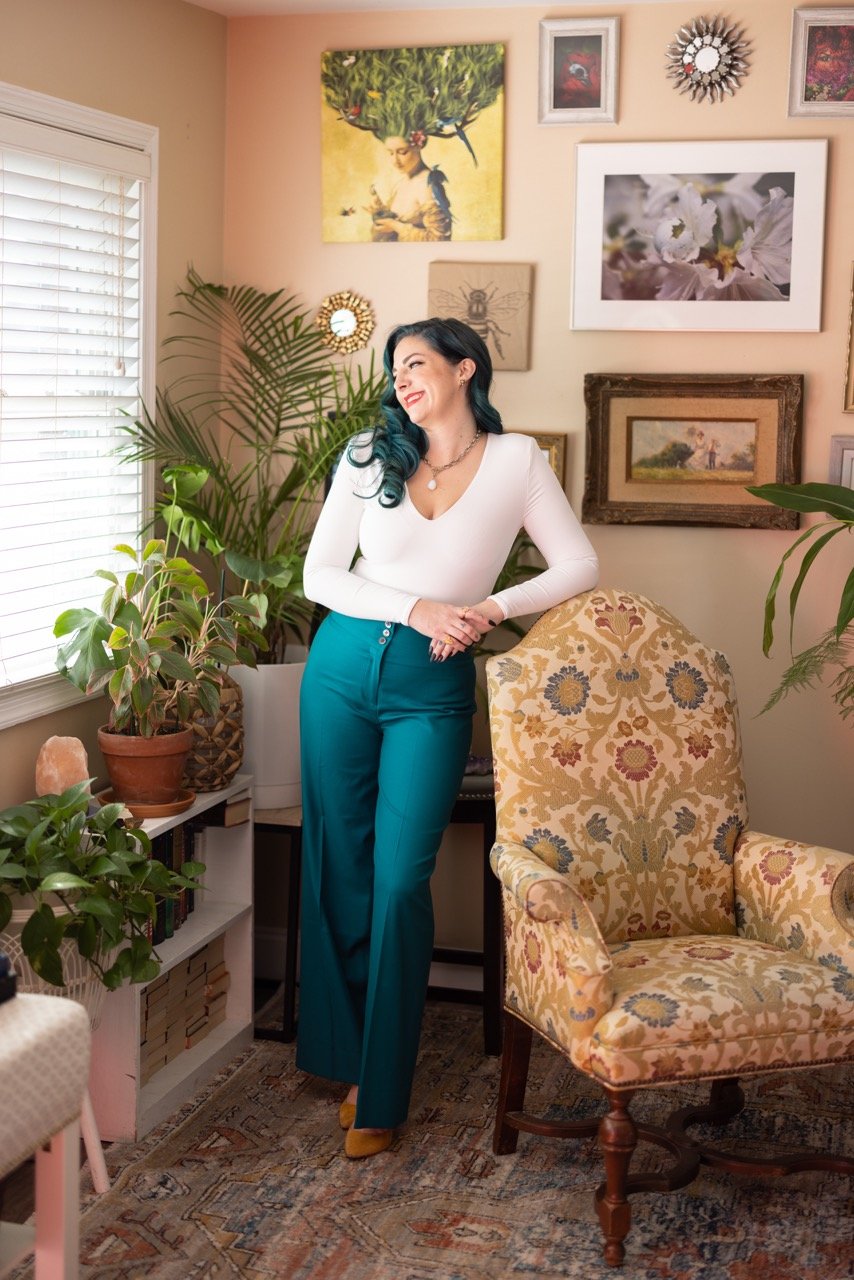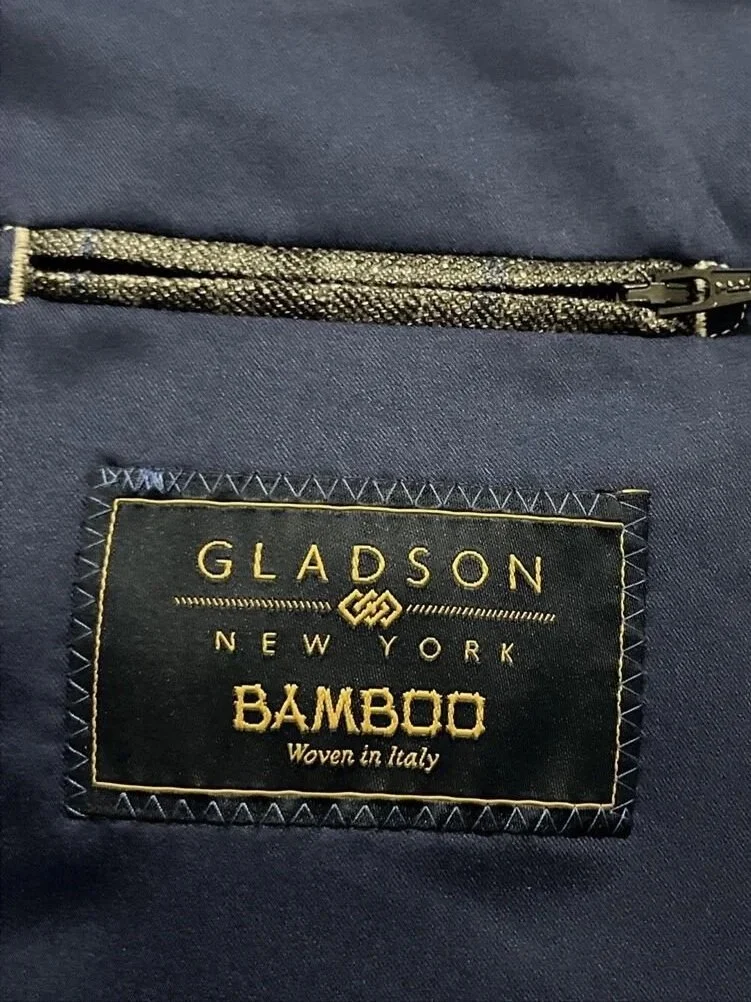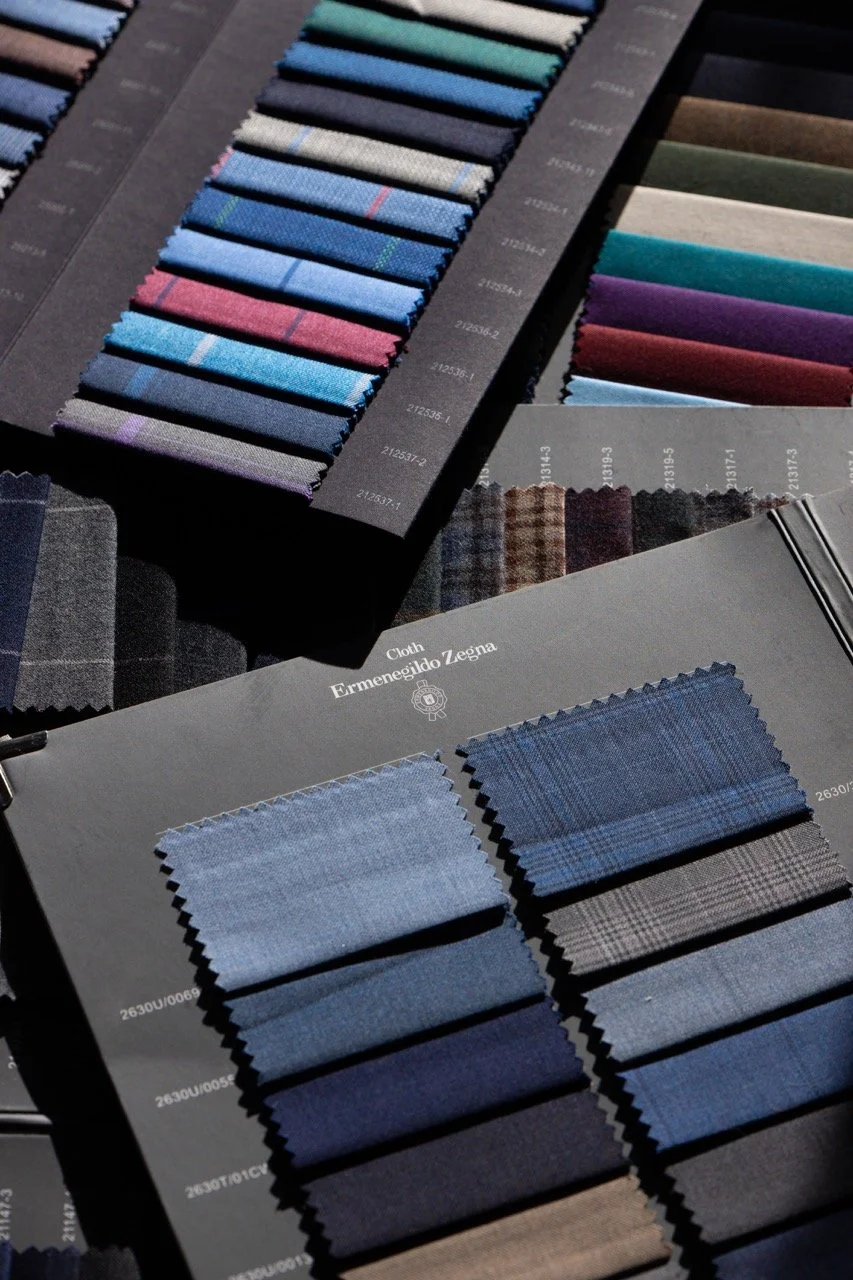2026 Suit Trends for Women
Women’s suiting in 2026 builds on everything that has been happening in men’s tailoring. Relaxed structure, better fabrics, and sharper proportions. This year’s suit style though is filtered through a very specific, female‑driven lens. The focus is on power, comfort, and personality: suits that move with the body, acknowledge curves or straight figures as needed, and can go from boardroom to dinner without feeling borrowed from a menswear rail.
An unstructured white cotton women’s suit from Capitol Hill Clothiers
The Relaxed Power Suit
The relaxed power suit is the backbone of 2026. It keeps the structure that makes a suit feel authoritative and removes the stiffness that used to come with that territory. Jackets are a little longer and shoulders are a little broader. The waist is shaped but not squeezed. Trousers tend to be straight wide or full length with a gentle flare rather than skinny or cropped.
This extra ease is about movement as much as style. When a suit has room in the torso and leg, it drapes nicely when you walk, sit, or climb stairs. The fabric swings in a controlled way instead of pulling at buttons and seams. That motion reads as confidence rather than carelessness. It also makes long days in tailoring more realistic because you are not fighting your clothes.
Proportion is what keeps these roomier cuts looking sharp. If the blazer is long and the leg is wide, then the base layer usually stays close to the body. A fitted knit, a tucked blouse, or a defined belt keeps a clear vertical line. Shoes also matter here. A block heel, sleek boot, or structured flat helps to anchor the volume and prevent the outfit from feeling bottom heavy.
For conservative or traditional workplaces, the same idea works at a slightly smaller scale. A blazer that covers the seat without being huge still feels current. A straight wide trouser that skims the hip without pooling at the ankle looks modern but not extreme. Those small adjustments keep you aligned with 2026 without feeling “fashion show” in formal rooms.
Statement Fits: Not Going Anywhere
Statement suits are one of the most powerful tools in a woman’s wardrobe for 2026. They give women a way to express strength, confidence, and individuality through bold colors, patterns, and cuts designed specifically for the female form. A statement suit might be a vivid cobalt blue with a sharply tailored blazer and wide-leg trousers that move fluidly. It could also be a suit in a rich violet or emerald green, or one with striking checks or pinstripes that emphasize feminine shape and proportion. These suits allow women to stand out in rooms where visibility and presence matter most, whether in boardrooms, client meetings, or on-camera presentations.
The importance of statement suits for women this year reflects a broader cultural shift toward embracing personal brand and leadership through fashion. Women are using their suits as a form of wearable empowerment, telling a story that combines professionalism with bold artistic expression. This is particularly relevant in spaces where women have had to constantly assert themselves or challenge traditional expectations. A well-fitted, brightly colored or patterned statement suit allows a woman to make a memorable, deliberate impression without sacrificing elegance or authority. The key to mastering this look lies in thoughtful balance—pairing vibrant colors and patterns with clean accessories, expertly tailored fits, and confidence in one’s own style narrative. When styled well, a statement suit becomes a visual amplifier for a woman’s voice and presence in any setting.
Feminine Tailoring and The Capsule Wardrobe
Feminine tailoring in 2026 focuses on shape and modularity. The aim is to keep the clarity of a suit and add movement and softness through cut. Many designers pair structured blazers with skirts that really move. These might be pleated, wrapped, or cut on the bias so they swing when you walk. The combination feels powerful from the waist up and fluid from the waist down.
Suit “systems” are a key idea. A single fabric might appear as a blazer, a waistcoat, a trouser, and a skirt. All of these pieces work together and also stand alone. This gives you more ways to adapt a single purchase to different days. You can wear blazer and trouser for a formal setting. You can wear waistcoat and skirt for a creative or social environment. You can use just the blazer with denim or just the trouser with a knit for casual days.
The cuts themselves respect that women favor different lines. Some pieces are shaped through the waist and hip with seams and darts. Others keep the torso straighter and balance that with volume in the leg or skirt. This allows a more feminine or a more androgynous effect using the same language of suiting. The key is that you choose where you want definition instead of having it dictated by stretch and tightness.
In real life, these modular sets remove a lot of decision fatigue. One coordinated group can cover a short work trip, a sequence of hearings, or a mix of in‑office and client days. You change the combination and the shoes and the same fabric tells different stories. This is especially helpful if you prefer a small, intentional wardrobe that still has range.
A Note on Capsule Wardrobes
A capsule wardrobe for women's suiting in Washington, D.C., offers an efficient and polished approach to dressing that suits the city's professional and varied social demands. The core idea is to curate a small collection of versatile suits and separates that mix and match effortlessly. This simplicity saves time and reduces decision fatigue, which is invaluable in a fast-paced, high-stakes environment like D.C. Investing in high-quality pieces in classic colors ensures you can easily transition from hearings to dinners without feeling over- or underdressed.
On the plus side, a well-thought-out capsule wardrobe can streamline your closet and make packing for business travel or extended workweeks far easier. D.C.'s climate requires choosing fabrics and cuts that can perform well in hot, humid summers and cool winters, which means layering and fabric selection are critical. However, building a capsule wardrobe takes discipline and upfront investment. You need to select pieces that are flexible enough to cover multiple roles yet tailored to your body and style. Without these, a capsule can feel limiting or repetitive.
For those ready to embrace this strategy, best practices include working with a trusted tailor or boutique that understands D.C.’s professional and social fabric. Capitol Hill Clothiers offers personalized guidance to help you identify the pieces that complement your body, color palette, and lifestyle. Our concierge service can assist you in creating a capsule wardrobe that balances timeless sophistication with modern practicality. This ensures your investment is efficient, cohesive, and truly supports the many facets of your daily life.
Sustainability Persists: NO POLYESTER
Sustainability has become a core value shaping how women approach suiting today. More buyers are demanding fabrics that honor both their bodies and the planet. This shift reflects a growing awareness of the environmental cost of fashion and a desire for tailoring that delivers lasting comfort and style. Suit fabric affects everything from how well a piece drapes, to how comfortable it feels in real-world conditions, to how long it lasts. Women’s suiting in 2026 is moving away from cheap synthetic blends toward natural fibers thoughtfully sourced to reduce environmental impact. The suits are no longer disposable; they are crafted to be altered, loved, and worn for years.
As 2026 unfolds, the use of organic and natural materials continues to grow in womenswear suiting. Responsible mills and designers are turning to wool, organic cotton, linen, hemp, and bamboo blends as alternatives to synthetics that have dominated budget tailoring. These fibers breathe better, age more gracefully, and avoid shedding microplastics common in synthetic fabrics. This means new suits feel lighter, move naturally with the body, and carry a far smaller environmental footprint over time. For women, this translates into garments that perform well across seasons, offer superior comfort, and fit a more mindful lifestyle.
Capitol Hill Clothiers has always maintained a clear stance on synthetics in tailoring. The brand’s philosophy emphasizes that most synthetic fabrics compromise not only the tactile pleasure of high-quality cloth but also its durability. While synthetics may be cheaper and easier to mass produce, they rarely offer the rich color depth, breathability, and graceful aging of natural fibers. This skepticism toward disposable, plastic-heavy suiting has only gained pertinence as sustainability has moved to the forefront of conversations in fashion. Women looking for suiting that honors both craft and ecology will find this approach aligns perfectly with their values.
For those unfamiliar with this perspective, Capitol Hill Clothiers offers in-depth style guides and essays that explore why natural and organic fibers feel better on the skin, how different weaves react in climates like the humid D.C. summer, and what to look for when commissioning or buying a custom suit that truly earns its place in your wardrobe. These resources reveal that choosing organic or natural cloth goes beyond environmental concerns. It is also a practical choice about comfort, longevity, and the kind of personal relationship you want with your clothes as trusted companions in your professional life.
Should I Avoid Polyester in My Suits?
The Real Reason You’re Getting “Shocked” All Winter: Synthetic Fabrics
Dressing for Value: The Cost-Per-Wear Approach to Your Wardrobe
Colors and Fabrics: Your Creative Direction
Color plays a much larger role in women’s suits for 2026. There is a strong push toward saturated shades such as cobalt, emerald, bright red, and violet. These colors often show up as full suits rather than as small accents. A strong shoulder and a clean line in a vivid color send a clear signal without needing loud styling. For many women, this becomes the “event” or “visibility” suit for panels, media, or important meetings.
Neutrals are evolving at the same time. Instead of only black and navy, there is more stone, ecru, sand, camel, and soft gray. These work especially well in tonal outfits. A stone suit with cream underpinnings and a light shoe creates one long column. A camel suit with tan shirt and brown belt does the same. This approach is flattering on camera and in person and reads calm and expensive without being showy.
Pattern and texture provide quieter interest. Pinstripes and chalk stripes have returned in softer cuts such as relaxed blazers and easy trousers. Checks and plaids appear in gentle palettes that feel less corporate and more everyday. Textured fabrics like crepe, twill, bouclé, and matte wool give depth and photograph well. They also hide small wrinkles more easily, which is useful on long days.
For a working wardrobe, the smartest approach is to mix one or two statement suits with one or two textured neutrals. The statement pieces cover days when you want to stand out. The neutrals carry the bulk of the week. Scarves, belts, jewelry, and shoes then fine‑tune each look. A simple change of accessory can shift the mood of the same suit from serious to approachable or from office to evening.
Color Analysis as a Tool
Before commissioning a custom suit, having a professional color analysis is one of the smartest ways to protect your investment and elevate your overall presence. A beautifully tailored suit in the wrong color can clash with your complexion, dull your natural features, and make it difficult to coordinate blouses, scarves, and accessories. On the other hand, knowing your ideal palette—whether you look best in cool charcoals, warm taupes, deep navies, or soft blues—means you select fabrics that complement your skin tone and bring out the brightness in your eyes and evenness in your complexion. This foundational understanding makes building and curating your wardrobe easier and more cohesive. Every blouse, sweater, or accessory you add will harmonize effortlessly, allowing you to create polished, versatile outfits rather than isolated pieces.
Capitol Hill Clothiers builds this step directly into the process by offering a complimentary color analysis with their concierge suit fittings in the D.C. area, so by the time you are looking at swatches and lapels, you are already working from a curated range of shades that are tailored not just to your measurements, but to your natural coloring and the environments you move in.
A Declining Trust of Social Media Recommendations
Sponsored content on instagram
In 2026, many women express a growing desire to move away from the relentless cycle of social media-driven consumerism. The constant flood of influencer endorsements, trend reactions, and curated ‘perfect’ lives can make shopping feel more about belonging to an online tribe than about genuine self-expression or quality. There is a fatigue setting in around the idea of buying to keep up with fast-changing, algorithmically boosted trends promoted by influencers whose main currency is attention, not expertise. Women are increasingly questioning whether what they see in Instagram Reels or TikTok collections truly aligns with their lifestyle, body, or values. This skepticism is driving a preference for brands and styles that feel timeless, authentic, and designed with the wearer in mind.
Influencer culture has played a powerful role in shaping fashion attitudes over the past decade. However, its dominance often leaves little room for nuance. The pressure to replicate what is ‘hot’ online can encourage impulse buys or brand loyalty based on visibility rather than fit, fabric, or function. Many women report feeling overwhelmed by the tidal wave of sponsored content, where sponsorships blur with genuine recommendations. This dynamic can erode trust and push shoppers toward more thoughtful, research-driven decision-making. A notable trend is the turn back to expert voices, well-curated boutiques, and trusted brands that emphasize craftsmanship over momentary hype.
In response, a growing number of consumers want to reclaim shopping as an experience centered on personal discovery rather than digital conformity. They value guidance that helps them understand what suits their individual proportions, colors, and professional needs. They want to build wardrobes of pieces that last well beyond a season’s viral moment and that work cohesively together. This movement is about undoing the ‘sheep’ mentality of chasing whatever is trending in the latest influencer drop and instead embracing intentionality. It encourages women to prioritize comfort, appropriateness, and longevity, recognizing that authenticity carries far more style capital than constantly reacting to online noise.
Brands that recognize this shift stand to gain loyal, engaged customers by fostering transparency, supporting education (such as in-person fittings and color analysis), and highlighting the tangible qualities of their garments beyond social media glamour. This approach signals respect for women as discerning buyers and partners in a long-term style journey. In practical terms, it means investing time in understanding personal style and fit, trusting professional advice, and choosing tailoring that serves both lifestyle and environmental ethics—values that align far better with today’s evolving fashion mindset than the fleeting buzz of influencer culture.
Must-Have Custom Suits for 2026
Making these trends useful comes down to a clear sense of your actual schedule. Start by mapping the kinds of rooms you enter most often. Courtrooms, Hill offices, boardrooms, campus settings, and creative studios each demand slightly different readings of tailoring. Then choose suits that can be calibrated up or down with small changes rather than entirely different wardrobes. A tight rotation might include one relaxed power suit in a neutral, one modular feminine set, and one colored or patterned suit. Each should fit comfortably through the torso and waist. Each should have sleeves and hems tailored to your real shoes. Each should coordinate with a small set of tops you already like to wear. This keeps your suiting in constant use rather than saved for rare occasions. Fabric choice should reflect both climate and commute. In a humid city with heavy air conditioning, unlined or half‑lined jackets in breathable wool or blends will see the most wear. Wide‑leg trousers that clear the ground by just enough will look elegant and avoid fraying. Choosing textures that resist shine and wrinkles will pay off in photos and late afternoons. The last step is alignment with personality. Tailoring looks best when it feels like an extension of who you are. If you are naturally quiet and analytical, soft neutrals and subtle patterns may feel truest. If you are high‑energy and visible, strong color or assertive stripes may support that. The 2026 landscape is broad enough that you can pick the elements that fit you and leave the rest.
Relaxed Power Suit
The relaxed power suit is a cornerstone of 2026 women’s suiting. It features slightly longer blazers with broader shoulders but softened tailoring that follows the body without constriction. Trousers tend to be wide-leg or straight with a comfortable rise. This style balances authority with comfort, allowing women to move freely while maintaining a commanding presence. The relaxed power suit works equally well in formal boardrooms as in creative offices, making it a versatile investment.
Modular Coordinated Sets
Women’s modular sets are redefining suiting by breaking the traditional two-piece mold. These collections often include a blazer, waistcoat, trousers, and skirt designed to mix, match, and layer in various combinations. This flexibility allows the wearer to adapt the look to different environments—from formal meetings to social events—without buying separate outfits. The cuts accommodate diverse shapes, including draped skirts and sharply tailored waistcoats, to balance femininity with structure.
Bold Colored Suits
Bright, saturated colors are a defining characteristic of 2026. Suits in cobalt blue, emerald green, lavender, or rich red make powerful fashion statements and elevate the wearer’s visibility in any room. These suits demand confidence and are often styled with minimal accessories to let the color shine. They are perfect choices for events where standing out positively while remaining polished is essential.
Soft-Neutral Tailoring
Alongside bold colors, soft-neutral suits remain essential for everyday professional wear. Shades like stone, camel, ecru, and warm gray provide a refined palette that is both flattering and easy to coordinate with other wardrobe pieces. Suits in these hues often feature subtle texture in fabrics such as crepe or matte wool, adding dimension without overwhelming the eye. They are particularly suited for women seeking classic, understated sophistication.
Feminine Tailoring with Skirts and Wraps
Feminine tailoring in 2026 embraces skirts, wrap dresses, and asymmetric hems paired with sharply tailored blazers. These styles combine the professionalism of a suit with movement and softness. The skirts often include pleats or bias cuts that flow naturally. This style is ideal for women who want the power of suiting but prefer silhouettes that emphasize fluidity and femininity over rigidity.
Each of these styles highlights how women’s suiting in 2026 prioritizes intention and personal expression. Whether commanding a boardroom or attending a casual client lunch, these must-haves ensure a wardrobe that is modern, versatile, and inherently stylish. Choosing the right combinations from these styles creates a strong foundation to express individuality while embracing current tailoring trends.







